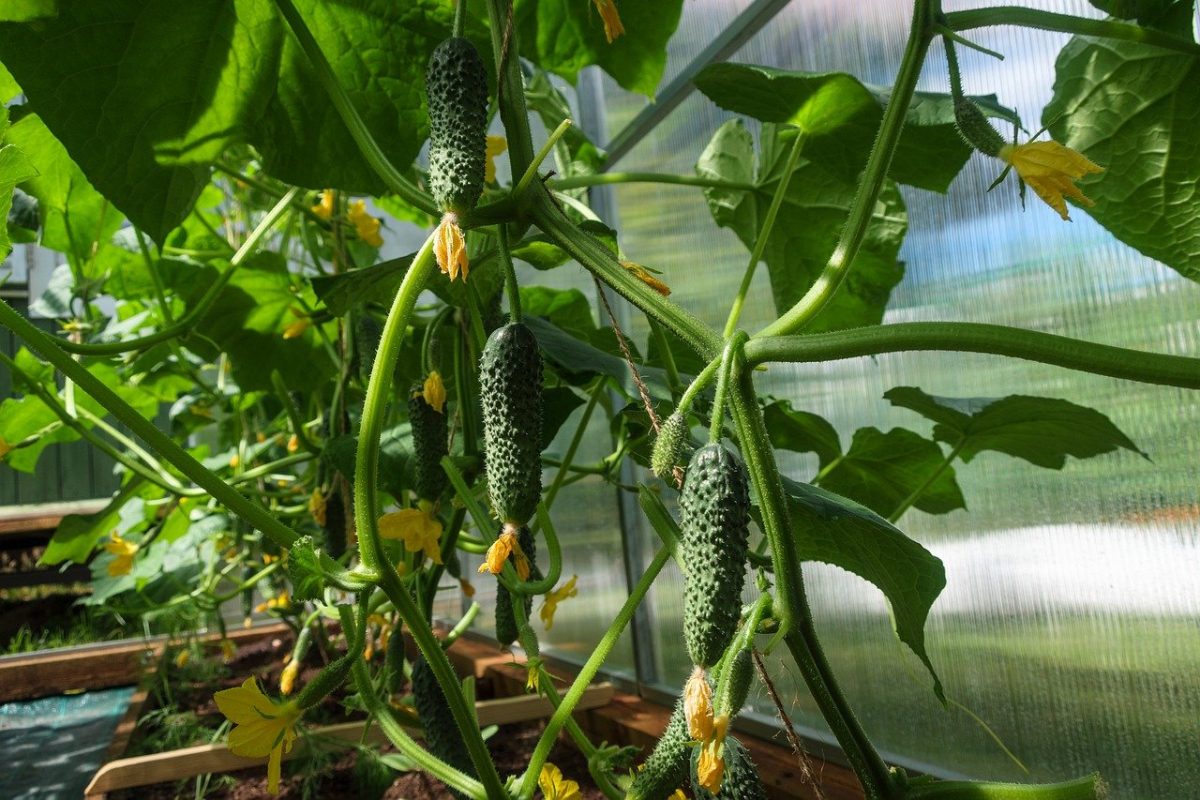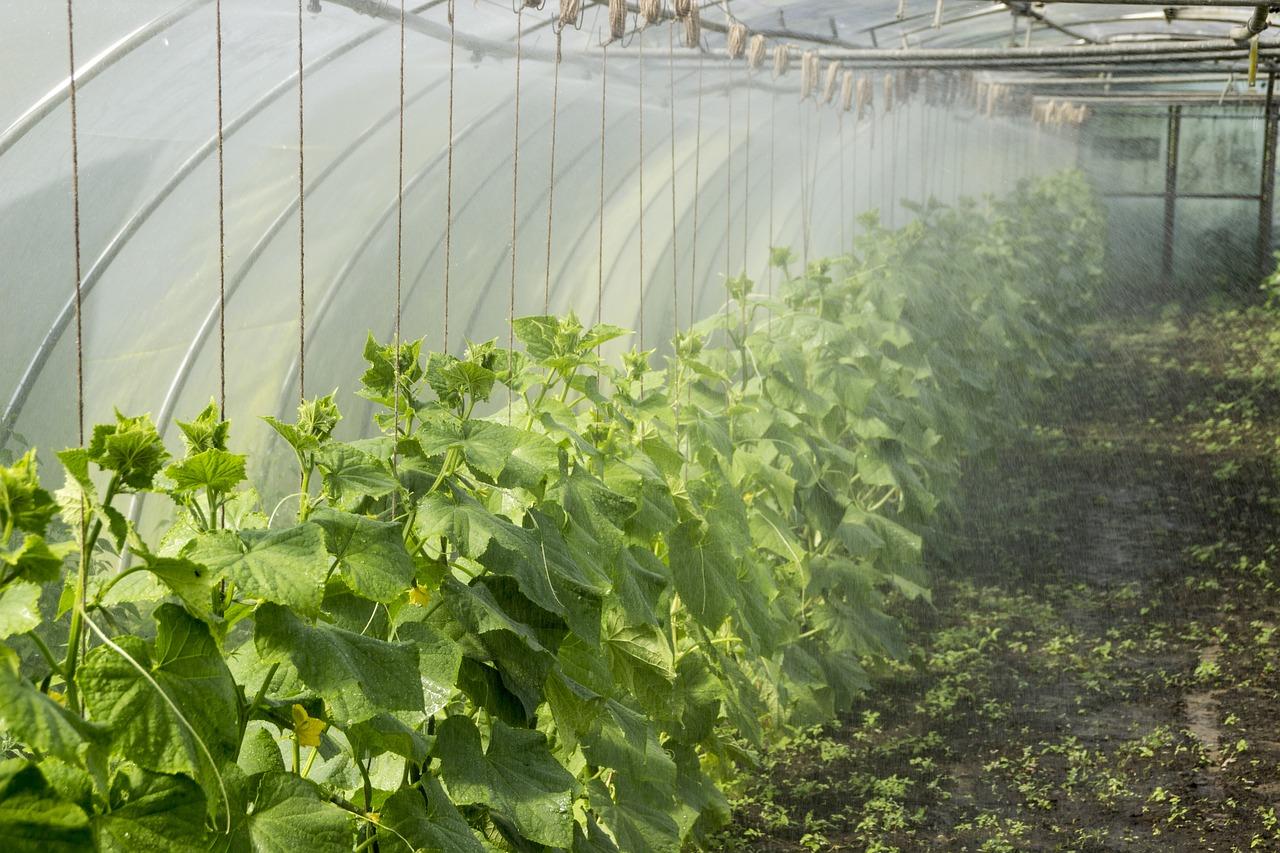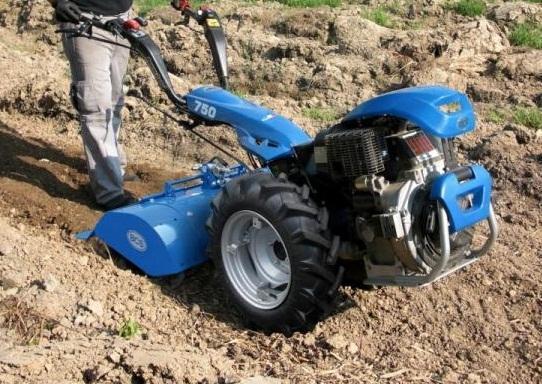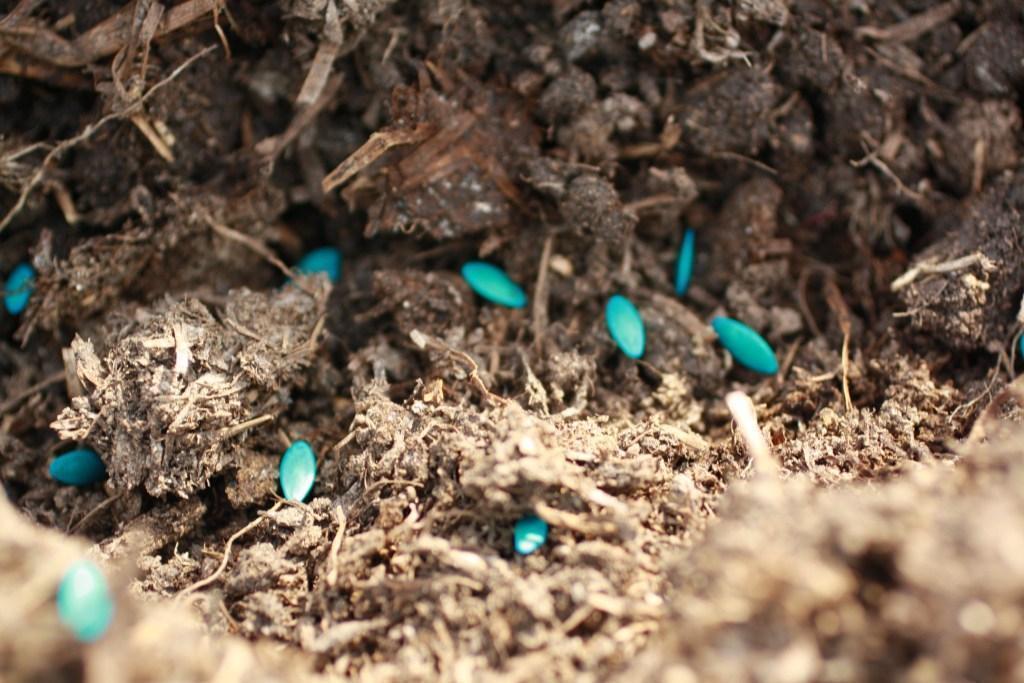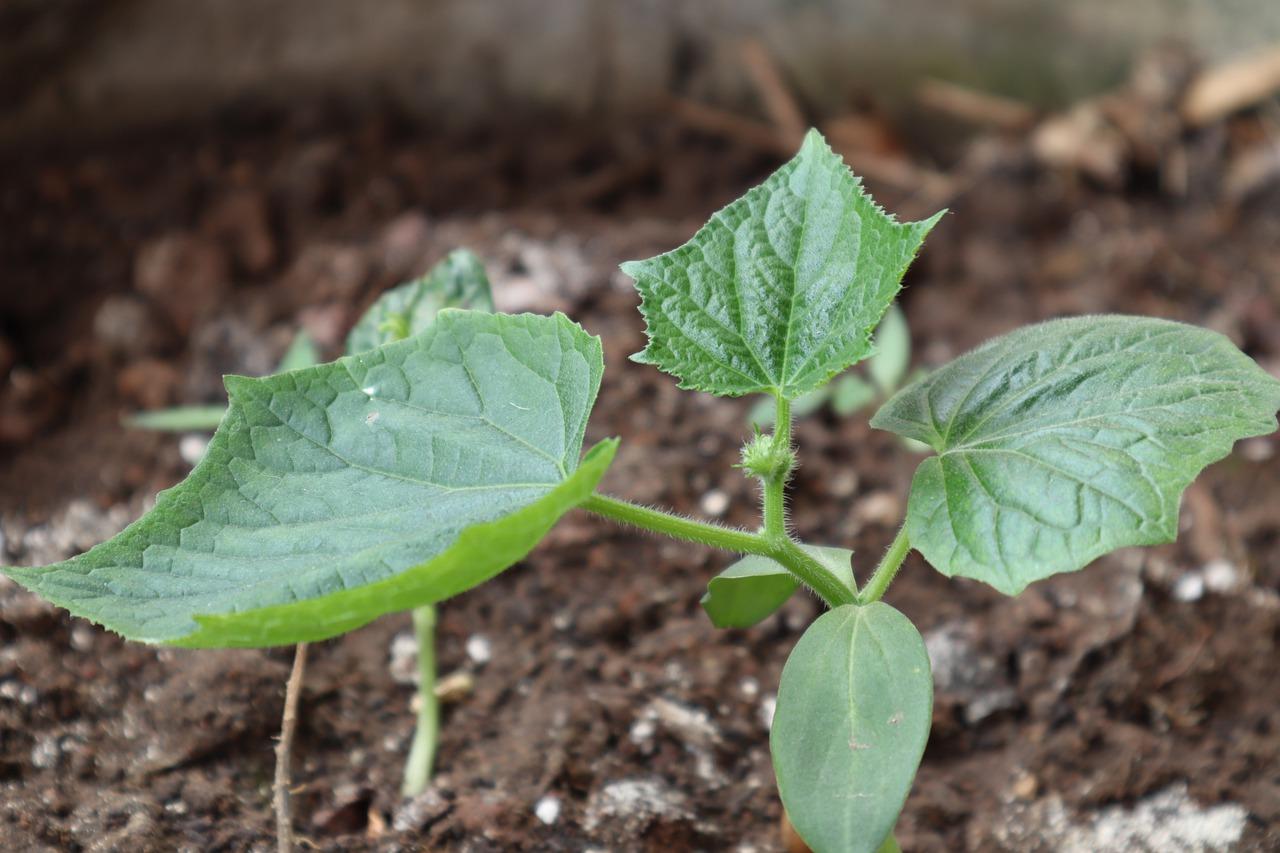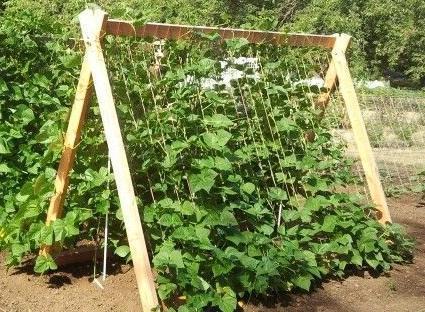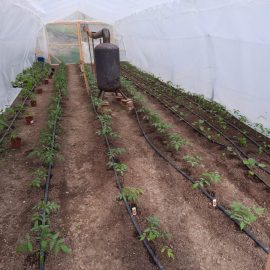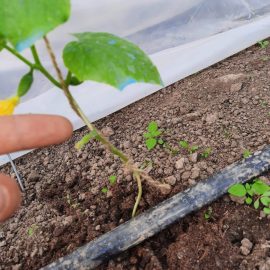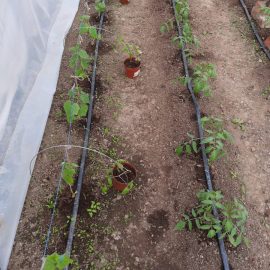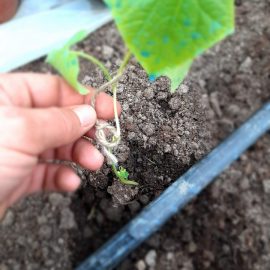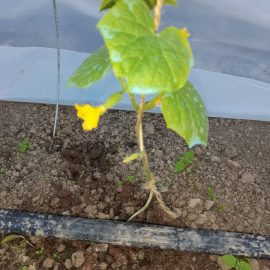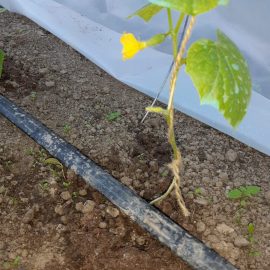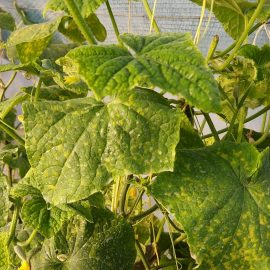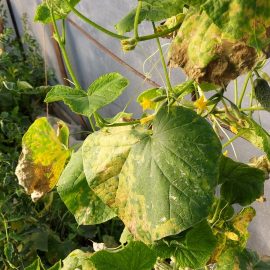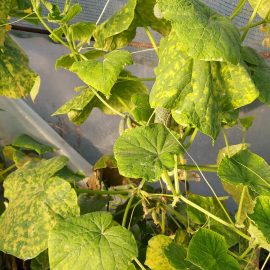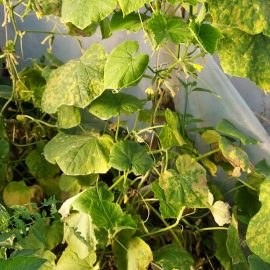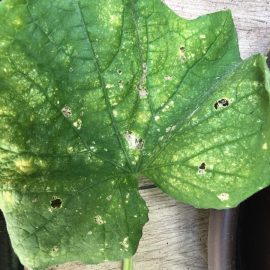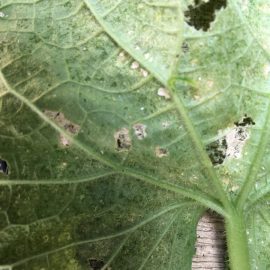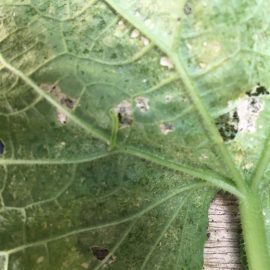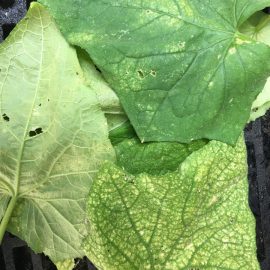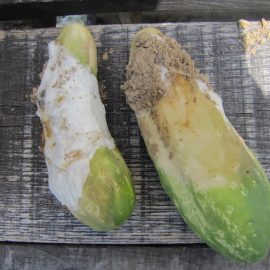Cucumber, information about crop management
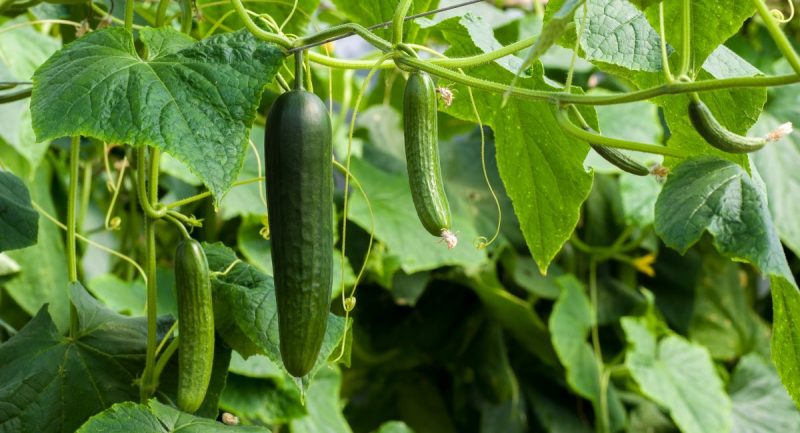
The cucumber (Cucumis sativus) is a vegetable plant cultivated for its fruits and is appreciated for its nutrient content. Cucumbers can be eaten fresh or processed. More than 90% of water, pectic substances, vitamins, and minerals are found in cucumbers. The specific flavor is given by the essential oils. Cucumber extract is being used in the cosmetics industry.
The cucumber is an annual plant with a poorly developed root system and high water requirements. The stem is creeping or climbing, pubescent, and has growths called tendrils, which help it to cling. The leaves are large, trilobed, alternately arranged, and covered with rough hairs.
The flowers are unisexual monoecious clustered in groups of 3 to 4. The female flowers have ovaries shaped like the future fruit and the male flowers are large and appear before the female flowers, mostly on the main stem. Pollination is entomophilous. If pollination is incomplete the fruit deforms or does not develop normally. In current crops, parthenocarpic hybrids are widely used, which form only female flowers and do not require pollination. The fruit is a pepo of different shapes, sizes, and colors. The seeds are flattened, elongated, ovoid, yellowish-white. The seeds keep their ability to germinate for 5-6 years.
Climate and soil requirements
The optimum growing temperature is 25-28℃ and the average temperature should not fall below 15℃. The minimum germination temperature is 15-16℃. Plants cannot tolerate temperatures below 12℃ or above 35℃, growth being stopped beyond these values.
The cucumber needs 12 hours of high-intensity light, the presence of blue-violet radiation stimulating plant growth. Humidity should be maintained at 75-80% of the field capacity for water. Insufficient water causes growth to stop and the number of fruits to decrease. Cucumbers are very sensitive to air currents and protective curtains should be created in the field to create a favorable microclimate for the plants. Cucumbers also prefer aerated, humus-rich, permeable soil with a neutral or slightly acidic pH.
Cultivation
Crop rotation
The soil should be flat, and leveled, with southern exposure and light texture (sandy loam or sandy loam). Cucumbers must not return to the same field for more than three years. The best results are obtained after alfalfa, clover, beans, potatoes, tomatoes, peppers, cabbage, or garlic. Do not grow after courgettes or melons.
Soil preparation
The operation starts in autumn by mobilizing the soil to a depth of 25 cm. This operation can be carried out with a tiller, tractor plow, or shovel. Before preparing the soil, you may apply semi-decomposed manure and chemical fertilizers. In spring, apply fertilizers with a higher nitrogen content or balanced fertilizers.
Recommended products
-
You can find products on a different store
Change Store -
You can find products on a different store
Change Store -
You can find products on a different store
Change Store -
You can find products on a different store
Change Store -
You can find products on a different store
Change Store -
You can find products on a different store
Change Store -
You can find products on a different store
Change Store -
You can find products on a different store
Change Store -
You can find products on a different store
Change Store -
You can find products on a different store
Change Store -
You can find products on a different store
Change Store -
You can find products on a different store
Change Store -
You can find products on a different store
Change Store -
You can find products on a different store
Change Store -
You can find products on a different store
Change Store -
You can find products on a different store
Change Store -
You can find products on a different store
Change Store -
You can find products on a different store
Change Store -
You can find products on a different store
Change Store -
You can find products on a different store
Change Store -
You can find products on a different store
Change Store -
You can find products on a different store
Change Store -
You can find products on a different store
Change Store -
You can find products on a different store
Change Store
Cucumber seedlings production
The cucumber crop can be established by seedling or seeds. As more and more parthenocarpic hybrids are used and planting material tends to be expensive, it is recommended to produce the seedlings in protected spaces and plant them in the field. Depending on the planting time, sowing can be carried out about 40 days before the planting date. Sowing should be carried out at a depth of 3-4 cm, preferably directly into seedling pots or in large alveolar trays. After 1-2 true leaves have formed, you can apply a special fertilizer to stimulate root development. Foliar fertilization with foliar fertilizers can be carried out, depending on the seedling’s needs, to supply them with the necessary elements for growth.
Planting
It can be done from the end of April in protected spaces and from May in the field, depending on environmental conditions. Cucumbers require a minimum of 16-18℃.
The planting scheme can be 200 cm between rows and 35 cm between plants per row. Planting should be done at the same depth as the plants were in the hotbed or pot.
After planting, it is recommended to water the plants and at the same time, you can also apply fertilizers that stimulate the rooting. With the next irrigation, a special fertilizer can be applied to improve fertility and soil structure and to create better root absorption conditions.
Recommended products
-
You can find products on a different store
Change Store -
You can find products on a different store
Change Store -
You can find products on a different store
Change Store -
You can find products on a different store
Change Store -
You can find products on a different store
Change Store -
You can find products on a different store
Change Store -
You can find products on a different store
Change Store -
You can find products on a different store
Change Store -
You can find products on a different store
Change Store -
You can find products on a different store
Change Store -
You can find products on a different store
Change Store -
You can find products on a different store
Change Store -
You can find products on a different store
Change Store -
You can find products on a different store
Change Store -
You can find products on a different store
Change Store -
You can find products on a different store
Change Store -
You can find products on a different store
Change Store -
You can find products on a different store
Change Store -
You can find products on a different store
Change Store -
You can find products on a different store
Change Store -
You can find products on a different store
Change Store -
You can find products on a different store
Change Store -
You can find products on a different store
Change Store -
You can find products on a different store
Change Store
Weed control
For weed control, shallow manual or mechanized hoeings should be carried out about 10 cm away from the plants. This aerates the soil and destroys weeds. Weed control can also be carried out chemically with herbicides approved for cucumbers.
Recommended products
-
You can find products on a different store
Change Store -
You can find products on a different store
Change Store -
You can find products on a different store
Change Store -
You can find products on a different store
Change Store -
You can find products on a different store
Change Store -
You can find products on a different store
Change Store -
You can find products on a different store
Change Store -
You can find products on a different store
Change Store -
You can find products on a different store
Change Store -
You can find products on a different store
Change Store -
You can find products on a different store
Change Store -
You can find products on a different store
Change Store -
You can find products on a different store
Change Store -
You can find products on a different store
Change Store -
You can find products on a different store
Change Store -
You can find products on a different store
Change Store -
You can find products on a different store
Change Store -
You can find products on a different store
Change Store -
You can find products on a different store
Change Store -
You can find products on a different store
Change Store -
You can find products on a different store
Change Store -
You can find products on a different store
Change Store -
You can find products on a different store
Change Store -
You can find products on a different store
Change Store
Pests and disease control
Apply recommended fungicide and insecticide treatments. It is best to alternate products that have different modes of action and active substances so that diseases and pests will not become resistant to the treatments.
Other works and maintenance tips for cucumber cultivation
Filling the gaps with soaked and pre-sprouted seeds or seedlings of the same variety or hybrid.
Fertilize the plants as soon as the first flowers appear, repeating 3-4 times at 20-day intervals. Organic fertilization can be applied using manure must or animal dung.
1-2 weeks after planting, apply phosphorus-rich or balanced fertilizers to encourage rooting. Foliar fertilizers can be applied depending on the plant’s needs and environmental conditions.
Recommended products
-
You can find products on a different store
Change Store -
You can find products on a different store
Change Store -
You can find products on a different store
Change Store -
You can find products on a different store
Change Store -
You can find products on a different store
Change Store -
You can find products on a different store
Change Store -
You can find products on a different store
Change Store -
You can find products on a different store
Change Store -
You can find products on a different store
Change Store -
You can find products on a different store
Change Store -
You can find products on a different store
Change Store -
You can find products on a different store
Change Store -
You can find products on a different store
Change Store -
You can find products on a different store
Change Store -
You can find products on a different store
Change Store -
You can find products on a different store
Change Store -
You can find products on a different store
Change Store -
You can find products on a different store
Change Store -
You can find products on a different store
Change Store -
You can find products on a different store
Change Store -
You can find products on a different store
Change Store -
You can find products on a different store
Change Store -
You can find products on a different store
Change Store -
You can find products on a different store
Change Store
During flowering and fruit growth, you can apply foliar fertilizers with a high content of calcium, boron for good fruiting, and root fertilizers with a high content of potassium.
Recommended products
-
You can find products on a different store
Change Store -
You can find products on a different store
Change Store -
You can find products on a different store
Change Store -
You can find products on a different store
Change Store -
You can find products on a different store
Change Store -
You can find products on a different store
Change Store -
You can find products on a different store
Change Store -
You can find products on a different store
Change Store -
You can find products on a different store
Change Store -
You can find products on a different store
Change Store -
You can find products on a different store
Change Store -
You can find products on a different store
Change Store -
You can find products on a different store
Change Store -
You can find products on a different store
Change Store -
You can find products on a different store
Change Store -
You can find products on a different store
Change Store -
You can find products on a different store
Change Store -
You can find products on a different store
Change Store -
You can find products on a different store
Change Store -
You can find products on a different store
Change Store -
You can find products on a different store
Change Store -
You can find products on a different store
Change Store -
You can find products on a different store
Change Store -
You can find products on a different store
Change Store
The fruiting is controlled by repeated pinching.
The operation consists of pinching the tips of the plant or the shoots. The first pinching out is done when the plant has 4 leaves. Thus the plant will form more shoots. The second pinching out is done when the formed shoots have 4 leaves. By pinching out, the plant will branch out and form more female flowers. When the plant has reached the desired size, the tips of the leaflets are broken off. This way the plant will stop growing and will form more flowers.
These rules do not apply to parthenocarpic cucumber hybrids. These are not pinched out, but the leaves and fruit are pruned to a height of 40 cm to allow the plants to develop. Later, the shoots can be left to grow and pinched out after 1-2 knots.
Irrigation
Cucumbers are water-loving plants and watering is even done daily during hot summer periods. Plants should be irrigated every few days in spring, depending on the temperature. For cucumbers, drip irrigation is the most recommended system. The critical periods for water are flowering and fruit formation and growth. Excess moisture in the soil causes root rot, especially at lower temperatures. High relative humidity leads to foliar diseases (downy mildew, powdery mildew). It is recommended to water the plants early in the morning.
To maintain soil moisture, the soil can be mulched by covering it with plant debris or special foils. Mulching causes the soil to warm up more quickly, adjusts soil moisture, maintains a good phytosanitary condition, inhibits weed growth, and reduces the number of maintenance works.
Trellising
Another operation that leads to production increases both in terms of quality and quantity is the cucumber trellis. This technology consists of driving cucumber plants vertically. This gives the crop more air, the plants make better use of solar radiation and the leaves and fruit are no longer in contact with the soil, greatly reducing the risk of disease.
Trellising can be done on the wire, and cucumber guidance can be done by periodically twisting the stem around the wire every 3 days. The stem is attached to the main structure of the trellising system, represented by the trellises and the wires.
Harvesting
The operation is carried out in the morning, after the dew has evaporated, by cutting the fruit stalk. If harvesting is not done in time and the fruit “ages”, the fruiting capacity of the plant decreases considerably. For this reason, the fruit must be harvested even daily during maximum production periods. The fruit should be harvested in stages or stored for a maximum of 10 days in controlled-atmosphere warehouses.
Peculiarities of cucumber crops in protected areas
In recent years, cucumbers have been grown almost exclusively in protected spaces, being heat-loving plants, which require trellising to facilitate certain works (treatments, care, harvesting). Crop establishment in protected spaces begins by removing the previous culture, destroying the outbreaks of infections, and restoring the polyhouse structure. It is also recommended to disinfect the soil with specific products.
Recommended products
-
You can find products on a different store
Change Store -
You can find products on a different store
Change Store -
You can find products on a different store
Change Store -
You can find products on a different store
Change Store -
You can find products on a different store
Change Store -
You can find products on a different store
Change Store -
You can find products on a different store
Change Store -
You can find products on a different store
Change Store -
You can find products on a different store
Change Store -
You can find products on a different store
Change Store -
You can find products on a different store
Change Store -
You can find products on a different store
Change Store -
You can find products on a different store
Change Store -
You can find products on a different store
Change Store -
You can find products on a different store
Change Store -
You can find products on a different store
Change Store -
You can find products on a different store
Change Store -
You can find products on a different store
Change Store -
You can find products on a different store
Change Store -
You can find products on a different store
Change Store -
You can find products on a different store
Change Store -
You can find products on a different store
Change Store -
You can find products on a different store
Change Store -
You can find products on a different store
Change Store
At least 10-12 days before the crop establishment, the polyhouse should be covered with foil to ensure a minimum temperature inside, for planting.
Controlling the growth factors is achieved by aerating the polyhouse and keeping the protective foil clean. Aeration must be done with caution so as not to create cold drafts. The temperature in the polyhouse should be 26-28 ℃ on sunny days, and the humidity should be 90%.














































































































































































































































































































































































































































